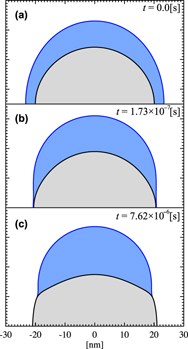Crossref Citations
This article has been cited by the following publications. This list is generated based on data provided by
Crossref.
Schwalbach, Edwin J.
Davis, Stephen H.
Voorhees, Peter W.
Warren, James A.
and
Wheeler, Daniel
2012.
Stability and topological transformations of liquid droplets on vapor-liquid-solid nanowires.
Journal of Applied Physics,
Vol. 111,
Issue. 2,
Shin, Naechul
and
Filler, Michael A.
2012.
Controlling Silicon Nanowire Growth Direction via Surface Chemistry.
Nano Letters,
Vol. 12,
Issue. 6,
p.
2865.
Krogstrup, Peter
Jørgensen, Henrik I
Johnson, Erik
Madsen, Morten Hannibal
Sørensen, Claus B.
Morral, Anna Fontcuberta i
Aagesen, Martin
Nygård, Jesper
and
Glas, Frank
2013.
Advances in the theory of III–V nanowire growth dynamics.
Journal of Physics D: Applied Physics,
Vol. 46,
Issue. 31,
p.
313001.
Schwalbach, Edwin J.
Warren, James A.
Wu, Kuo-An
and
Voorhees, Peter W.
2013.
Phase-field crystal model with a vapor phase.
Physical Review E,
Vol. 88,
Issue. 2,
Muralidharan, Srevatsan
Voorhees, Peter W.
and
Davis, Stephen H.
2013.
Nonaxisymmetric droplet unpinning in vapor-liquid-solid-grown nanowires.
Journal of Applied Physics,
Vol. 114,
Issue. 11,
Nukala, Pavan
and
Agarwal, Ritesh
2014.
Semiconductor Nanowires.
p.
111.
Frolov, Timofey
Carter, W. Craig
and
Asta, Mark
2014.
Capillary Instability in Nanowire Geometries.
Nano Letters,
Vol. 14,
Issue. 6,
p.
3577.
Wang, Yanming
Santana, Adriano
and
Cai, Wei
2017.
Atomistic mechanisms of orientation and temperature dependence in gold-catalyzed silicon growth.
Journal of Applied Physics,
Vol. 122,
Issue. 8,
Wang, Yanming
McIntyre, Paul C.
and
Cai, Wei
2017.
Phase Field Model for Morphological Transition in Nanowire Vapor–Liquid–Solid Growth.
Crystal Growth & Design,
Vol. 17,
Issue. 4,
p.
2211.
Siddiqi, Georges
Pan, Zhenhua
and
Hu, Shu
2017.
Semiconductors for Photocatalysis.
Vol. 97,
Issue. ,
p.
81.
Wang, Nan
Upmanyu, Moneesh
and
Karma, Alain
2018.
Phase-field model of vapor-liquid-solid nanowire growth.
Physical Review Materials,
Vol. 2,
Issue. 3,
Hallberg, Robert T
Messing, Maria E
and
Dick, Kimberly A
2019.
Nanowire morphology and particle phase control by tuning the In concentration of the foreign metal nanoparticle.
Nanotechnology,
Vol. 30,
Issue. 5,
p.
054005.
Yang, Yao
Li, Shaorong
Liang, Yuxin
and
Li, Bangsheng
2020.
Effect of temperature on wetting kinetics in Al/SiC system: a molecular dynamic investigation.
Composite Interfaces,
Vol. 27,
Issue. 6,
p.
587.
Nowak, Katarzyna
Galuskina, Irina
and
Galuskin, Evgeny
2020.
Greenockite Whiskers from the Bytom Burned Coal Dump, Upper Silesia, Poland.
Minerals,
Vol. 10,
Issue. 5,
p.
470.
Wang, Zi-Le
Liu, Zhirong
Huang, Zhi-Feng
and
Duan, Wenhui
2020.
Minimal phase-field crystal modeling of vapor-liquid-solid coexistence and transitions.
Physical Review Materials,
Vol. 4,
Issue. 10,
Jevasuwan, Wipakorn
and
Fukata, Naoki
2021.
Functionalized aluminum-catalyzed silicon nanowire formation and radial junction photovoltaic devices.
Nanoscale,
Vol. 13,
Issue. 14,
p.
6798.
Razaghi, Zhina
and
Zhu, Guo-zhen
2023.
Microscopic Characteristics of Kinking Phenomenon in Vertically Free-Standing Nanowires.
Crystals,
Vol. 13,
Issue. 10,
p.
1459.
Jevasuwan, Wipakorn
Abdelbar, Mostafa
Jeco-Espaldon, Bernice Mae Yu
Abdelhameed, Mohammed
Sodabanlu, Hassanet
Zhang, Qinqiang
Okada, Yoshitaka
and
Fukata, Naoki
2023.
Paper-Thin Al-Catalyzed Si Nanowire Solar Cells and Efficiency Enhancement by Hybrid Nanostructures with Mn-Doped Perovskite Nanocrystals.
ACS Applied Energy Materials,
Vol. 6,
Issue. 13,
p.
7169.
Spencer, Brian J.
2024.
Liquid drop shapes on hexagonal substrates: corner dewetting in the context of vapor–liquid–solid growth of nanowires.
Journal of Engineering Mathematics,
Vol. 147,
Issue. 1,
Erofeev, Ivan
Saidov, Khakimjon
Baraissov, Zhaslan
Yan, Hongwei
Maurice, Jean-Luc
Panciera, Federico
and
Mirsaidov, Utkur
2024.
3D Shape Reconstruction of Ge Nanowires during Vapor–Liquid–Solid Growth under Modulating Electric Field.
ACS Nano,
Vol. 18,
Issue. 34,
p.
22855.
